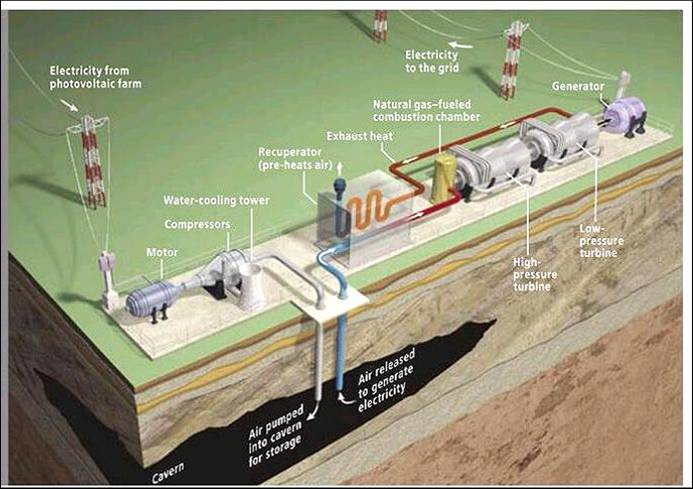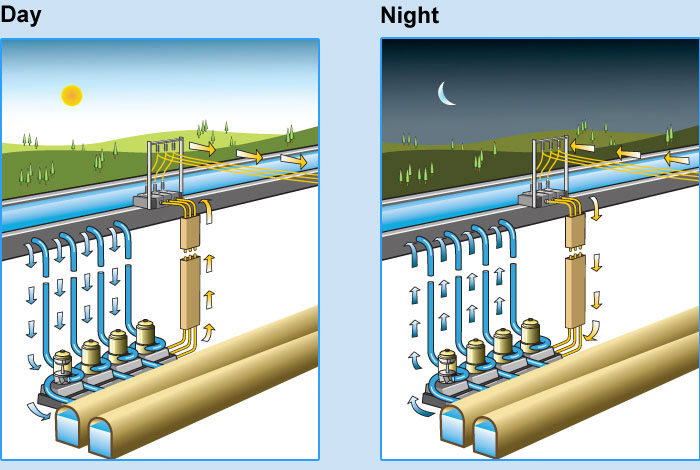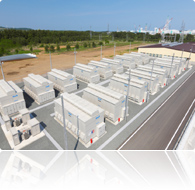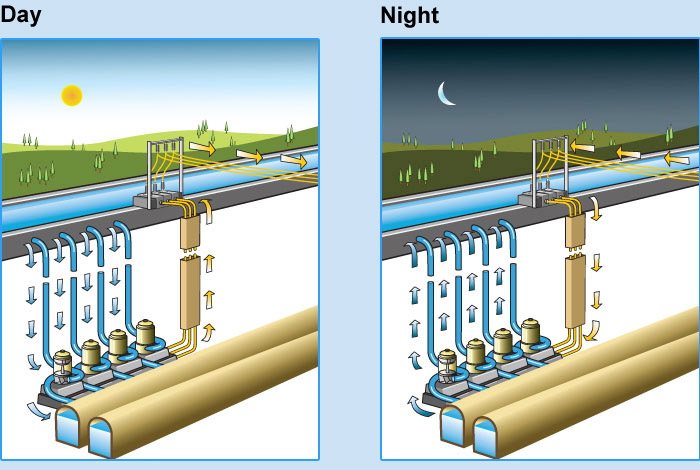As the world meets this December to set plans to halt global warming, it is expected America and other industrial nations will commit to a daunting task: reduce CO2 emissions 80% by 2050. In just 40 years, a complete revolution in how we use and supply our power must happen, or the world will face catastrophic effects of runaway climate changes.
As a new power plant typically lasts 40-50 years, many scientists are now arguing we must simply stop building new power systems that use significant amounts of fossil fuels. They argue we must move to a high reliance on the wind and the sun for our electricity.
Abundant Power. The U.S. has enormous wind resources, capable of generating over 20% of U.S. electricity from wind by 2030 (PDF), according to the U.S. Department of Energy.
The sunlight falling on our deserts, parking lots, and rooftops has even more power — enough to supply 69% of U.S. electricity by 2050 according to published studies.
Other renewable power sources — such as geothermal energy, municipal waste-to-energy, and biomass — will also play a role, but they pale in size compared to the gargantuan resources of wind and sunlight.
How We Use Energy vs. How Nature Provides. Though nature provides all the energy we may need, there is a problem. We demand power literally “at the flick of a switch”, not just when the wind is blowing or the sun is shining.
This basic fact about how we use power versus how nature supplies clean energy has caused many to discount the idea that wind or solar power can ever supply more than a small fraction of our electricity. Critics of renewable electricity call it “intermittent” and “unreliable”. They say we can’t “catch the wind”, nor can we command the sun to always shine.
These critics see two possible choices for the future. We can develop more stable supplies of renewable energy by coupling wind and solar projects with storage. Failing that, they argue we should give up on renewables as a primary source of electricity, and instead build more nuclear power.
The flaw in the nuclear path, beyond its tremendous cost, long lead times, and imported fuel, is that nuclear is not actually “dispatchable” power. Nuclear plants are designed to run all the time at fairly steady output — meaning nuclear power cannot provide the “peaking power” now provided by gas turbines. Thus, a nuclear path would still rely heavily on fossil fuel power plants to “ramp up” on a daily basis to provide the power needed during these daily swings.
A truly dispatchable system providing over 80% reductions in carbon emissions, therefore, must rely on some form of energy storage. The energy storage can allow us to fully utilize wind and sunlight as our main power sources — supplying both “base load” power and dispatchable daily peaking power with energy from these inexhaustible supplies.
Energy Storage and Today’s Grid. Despite critics, wind farms and solar photovoltaics are already feeding zero-fuel-cost power into today’s electric grid with little or no energy storage. At current levels, the fluctuations in wind and solar output are backed up by the same “load-following” and “peaker” natural gas power plants that already must handle wild fluctuations in customers’ demands for electricity. Indeed, the DOE’s “20% Wind by 2030” scenario modeled how wind could supply this very significant portion of U.S. electricity needs even with no storage of the wind power.
As long as natural gas remains cheap and acceptable to use, many argue that developing ways to store wind or solar energy may be a case of “a solution in search of a problem”. They note natural gas peaking plants are cheap to build and don’t need to operate much more than they already do, to provide firming power to renewables.
“Different sectors like to associate with wind power,’ the NY Times quoted Robert E. Gramlich, policy director at the American Wind Energy Association. “But we don’t want to give anyone the impression that storage is needed to integrate wind. Even growing 20-fold, storage isn’t needed.”
A Better Way. Though wind and solar can be integrated without storage for a long time to come, energy storage proponents argue that coupling wind or solar power with utility scale energy storage is a “Better Way”. If stored wind or solar energy instead of natural gas plants can be used to generate power when the wind is not blowing or the sun is not shining, less natural gas will be burned to provide dispatchable power.
Though storage will cost money, burning less natural gas will save money on fuel costs. Also, there are now times when excess wind farm kWh’s have been sold onto the grid at extremely low prices or even given away, because they occurred in the middle of the night when there was very low demand for power. Storing that wind energy, for sale of kWh’s the next day when prices are higher, would generate more revenue. While less dramatic, solar power production can also be shifted to higher-demand periods, from solar noon to late afternoon/early evening when utilities typically experience maximum summer peak demands.
The most important motivator, however, to find a “Better Way” is the need to achieve phenomenal reductions in CO2 emissions. While it may take until 2030 to reach a 20% contribution to the grid, what then? Going beyond this level will require dispatchable renewable power. Twenty years is within the lifetime of any new power plant built today, so storage proponents argue we should already be building to achieve minimum levels of fossil fuel use.
Compressed Air Energy Storage (CAES). A proven technology, ready to use now, for economical storage of massive amounts of renewable power is to compress air at very high pressures, and store this compressed air in large underground caverns, depleted wells, or aquifers. When the wind turbines and solar plants reduce output, and power is needed, the compressed air is released and run through turbines to generate power:

Source: Scientific American
Because the caverns or aquifers are so large, hundreds of hours of output can be stored, providing the ability to cover very long “doldrum” wind periods or stretches of cloudy days. Most CAES turbines can also run in natural gas-only mode in the extreme event the cavern becomes fully depleted. A reliable, fully dispatchable electricity generation system is provided.
CAES has a well established track record at scale. A 280 MW plant in Hunthorf, Germany has run since 1978, and a 110 MW plant at McIntosh, Alabama has been in continuous operation since 1991.
CAES systems use gas turbines almost identical to normal natural gas peaking turbines. However, they only use about 1/3 the natural gas, because 2/3 of the natural gas energy in a regular turbine is used to compress air before it enters the turbines, and this compressed air would now be supplied by the stored air. Natural gas would still be needed to heat the air before it enters the turbines.
CO2 Reductions. While not a 100% carbon free power system, a wind or solar coupled CAES power plant system can achieve >80% reductions in fossil fuel use. A baseload CAES/wind system (designed to provide at least 85% Capacity Factor power to the grid) would typically provide half of its total power directly from the wind farm to the grid, without cycling through the CAES plant. The other half of kWh’s supplied to the grid would come from stored energy in the CAES, at about 1/3 normal fossil fuel use. Total fossil fuel use per delivered kWh would thus drop to roughly 1/6 of a normal fossil fuel plant, an over 80% reduction in CO2 output.
A carbon-free electric system is also possible, with CAES plants fitted with thermal storage. The thermal storage would store heat from compressing the air, for later use to heat the air going to the turbines. Known as “adiabatic” CAES plants, the stored thermal energy replaces the need for natural gas, causing the entire system to run on renewable power alone. Because thermal storage is costly, it is not expected CAES plants installed in the next decade will include it. However, a regular CAES plant can later be retrofitted with thermal storage, when it becomes more economical or society demands zero-carbon power.
Geological Formations Suitable for CAES. A nationwide network of CAES plants could use the same types of geological formations, and depleted gas wells, as are currently used to store most of the nation’s natural gas supplies. Wide areas of the U.S. — most notably the wind-rich central states — have these formations and depleted wells:

Source: Coha and Louks (1991)
Cost of Renewable/CAES Power Systems. Because the caverns, aquifers, and wells are already there, CAES offers very economical energy storage.
Estimates for CAES plants range from $750/kW of generating capacity up to about $1,200/kW, with the difference being primarily the number of hours of energy storage. A wind farm/CAES system (taken as a whole) capable of providing baseload capacity factors of 85% could be built for around $5,900/kW of equivalent baseload capacity, including the wind farm itself and the CAES facility. While this is far more than a natural gas plant, it is comparable to a new coal fired power plant and at least 1/3 less costly than the same capacity if added through nuclear power.
Unlike a nuclear or coal plant, the CAES plant would be fully dispatchable power, able to increase and decrease its output along with fluctuating customer demand. This flexibility is a major advantage for usefulness to the electric grid.
Total costs/kWh from this system would also be competitive. Estimates indicate that if the wind farm is built with the 30% Federal Tax Credit (still available through 2012), a total wind/CAES system could deliver baseload power to the grid at about 10.5 cents/kWh. This cost would rise to about 13.0 cents/kWh without the wind Tax Credit. (Effectively, the Tax Credit if used wisely could pay for the CAES plant to convert an intermittent wind farm into firm, dispatchable power.)
Though more expensive than kWh’s from a new baseload natural gas power plant (which would probably be about 9 cents/kWh), a wind/CAES system would be well protected from future fuel cost increases. Also, at 10.5-13.0 cents/kWh, the baseload wind/CAES system would only be about half the cost/kWh from a new nuclear power plant.
Pump Water Up and Let it Fall Back Down. Pumped hydro-electric storage is just that simple — when you want to store energy, use electricity to pump water to a high level. Then, whenever power is needed, let the water fall through hydroelectric turbines to generate power. You don’t get all your electricity back (about 22% is lost), but you get it when you need it. This enables you to accept power from renewable sources when not needed, and store it for use later.
Pumped hydro storage is the largest utility energy storage method in the world, with 20,800 MW already in use in the U.S. However, its use has slowed because of limited sites for hydroelectric power dams.
Enter Riverbank Power Corporation, with its simple idea: combine two well-established technologies into one. First, use standard deep mining techniques to create a large cavern 2,000 feet deep, under a body of water such as a river or abandoned quarry. Then, install 4 gigantic 250 MW hydroelectric turbines at the bottom of shafts, for a massive 1,000 MW power supply available on demand. When power is needed, let water fall down the shafts and generate power. When renewable power is available, pump the water back up.

Source: Riverbank Power
Riverbank Power is now actively exploring 15 sites in the U.S. and Canada, for selection of its first five 1,000 MW pumped hydro (AquabankTM) facilities. Wiscasset, ME is high on the list, where Riverbank has already performed successful bore hole tests of the underlying rock. The Wiscasset site is very symbolic, as it is the home of the former Maine Yankee nuclear power plant, decommissioned more than a decade ago. A boon to Riverbank Power is the site is still set up to connect directly to the transmission grid.
Costs. Because Riverbank Power has to dig out its own cavern, its cost to construct is significantly higher than a CAES plant — estimated at $2 Billion for the 1,000 MW facilities, or roughly $2,000/kW. Also, instead of dozens or hundreds of hours of storage, Riverbank plants are designed to run for 6 continuous hours before the water would need to be pumped back up. The timetable is good for hour-to-hour or minute-to-minute fluctuations but not long stretches with no wind or sun.
Riverbank is confident of its business plan, and is not asking for taxpayer or utility dollars. Its turbines use no fossil fuels, and the facility should last 100 years. The company plans to buy power at cheap prices, and sell power when it is needed more, at a higher price.
If it does that for 100 years, the Company feels it should pay for the initial $2 Billion investment many times over, while creating jobs and giving green energy developers a solid market for their power.
Batteries to Store Power When and Where Needed. While both CAES and pumped hydro storage plants hold the promise of very large scale economical storage, they both require special siting. CAES requires an available underground cavern, well, or aquifer, while pumped hydro requires a water resource. Batteries, however, can go virtually anywhere, and take almost no lead time compared to the larger projects.
Xtreme Power is a company out there today, already selling product, by identifying customers who have needs and who are willing to pay for solutions. The company has a systems approach employing modular battery packs that can be scaled to provide Mwh of power storage, together with power electronics control systems.
Xtreme Power can shift 4 hours of power to a later time, for roughly 5-10 cents/kWh. In many electricity markets, the difference in value between different times of the day can more than pay for this cost.
The company has some large scale systems going in before the end of this year, and plans to deliver at least 75 – 100 Mwh of power storage in 2010, with more that can be delivered. Most of its customers are large solar and wind developers, who are eager for a solution and ready to pay for it now.
 NGK Insulators
NGK Insulators
Sodium Sulfur (NaS) Batteries. Another battery solution which is also already commercially available is sodium sulfur. Xcel Energy has a 1 MW NaS battery installation underway from NGK Insulators to store up to 7.2 Mwh (in other words, over 7 hours of power), of wind energy for use when most needed. The system will be adjacent to an 11-MW wind farm owned by Minwind Energy LLC, in Luverne, Minnesota.
Let’s Not Store These Ideas For Later. When renewable energy was still a long way off, the solution to energy storage seemed to be the unattainable “Holy Grail”. It was always to be found, yet never found.
Now, however, the answers are actually here, and they are simpler and plainer than we expected, Store air. Pump water. Use advanced batteries. Like Indiana Jones in his Last Crusade, we need to know when the true Grail is right in front of us.
As Michael Breen from Xtreme Power told me, “Let’s stop jabbering about it … We just need more demonstration units so the industry can talk about this more intelligently.”
This is now happening. Is the Holy Grail finally found?



